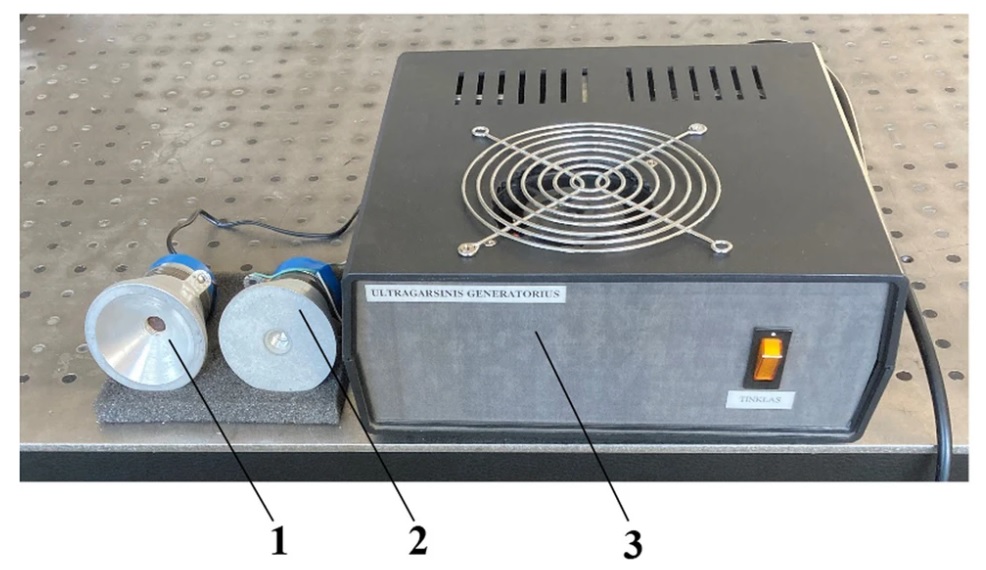A study conducted by scientists from Kaunas (Lithuania) universities revealed the possibility of non-invasively reducing blood pressure and speeding up gas exchange within the pulmonary system. The findings were confirmed in vivo – within 7 minutes, lung oxygen saturation of the test subjects improved by more than 10-15%, and blood pressure and heart rate decreased.
To combat respiratory infections such as COVID-19 that cause pulmonary hemodynamic changes, like pulmonary hypertension (PH), it is necessary to develop new emergency measures to quickly protect the affected person. This was achieved by using a low-frequency ultrasonic device developed at the Institute of Mechatronics of the Kaunas University of Technology (KTU).
An innovative low-frequency ultrasonic transducer was invented
KTU professors Vytautas Ostaševičius and Vytautas Jūrėnas say that in contrast to commonly used ultrasonic transducers that exclusively generate only longitudinal modes of vibration, this newly developed and currently patent-pending transducer operates in a higher radial mode of vibration.
This shift has led to enhanced acoustic signal penetration, made the signal less scattered and allowed to increase in the acoustic effect on deeper biological tissues, consequently adapting the developed device for therapeutic applications.
This was confirmed by in vivo tests on sheep at the Biological Research Centre of the Lithuanian University of Health Sciences, Laboratory of Membrane Biophysics (LSMU). The measurements of the physiological parameters of anesthetised sheep showed that the penetration of the ultrasonic acoustic wave through the biological tissues of the developed transducer is 4 times higher than that of the previously used devices. Within 7 minutes, lung oxygen saturation improved by more than 10-15%, and blood pressure and heart rate decreased.
A fast-acting non-invasive tool for the therapy of pulmonary hypertension
“These findings suggest a great opportunity to non-invasively provide a therapeutic effect to people with pulmonary hypertension, improving their quality of life and reducing drug dependence,” says Prof. Ostaševičius.
He goes on to explain that the exchange of gases in the blood intensifies thanks to the acoustic waves caused by low-frequency ultrasound travelling through the patient’s blood vessels, which dissociate erythrocyte aggregates into single erythrocytes.
Blood pressure decreases due to the spaces between the blood cells, and the number of single dissociated erythrocytes per unit volume becomes smaller than the aggregates of erythrocytes not affected by ultrasound. This significantly reduces blood viscosity. The viscosity of human blood is directly proportional to the haematocrit (the concentration of erythrocytes), which is responsible for the transport of oxygen and carbon dioxide.
There are a multitude of possible medical applications
“High-frequency ultrasound, currently used in medical practice, stimulates the aggregation of blood particles by exciting standing acoustic waves in the liquid phase of blood, where aggregated erythrocytes accumulate in the nodes,” explains Prof. Jūrėnas.
The aggregation of human erythrocytes is a major cause of many pathological conditions, from bacterial infections to cancer. In contrast to the standing waves produced by high-frequency ultrasound, low-frequency propagating acoustic waves cause the opposite phenomenon, the dissociation of erythrocyte aggregates.
In collaboration with the medical community, KTU researchers are preparing to explore a new method of drug delivery into ultrasonically dissociated single erythrocytes, that ensures safe drug encapsulation, avoiding ex vivo processing of erythrocytes.
“Our proposed method saturates erythrocytes with drugs in the in vivo environment of the human body,” explains Prof. Ostaševičius.
Other possible applications of the precisely oriented low-frequency ultrasound acoustic signal for clinical research are blood clot destruction of calcified aortic stenosis.
The article “Low-frequency ultrasound for pulmonary hypertension therapy” was published in Respiratory Research 2024, 25, Article number: 70 (2024) and can be accessed here.




